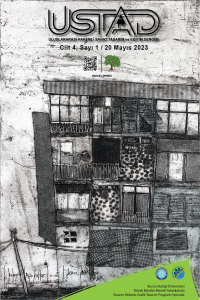Hacû-yi Kirmâni’nin “Kemâlnâme” mesnevisinde Nizâmî Gencevî’nin etkisi
Doğu edebiyatında epik şiirin gelişimi, aynı zamanda Nizâmî Gencevî mesnevilerinin etki alanının incelenmesi, edebiyat çalışmalarının güncel sorunlarından biri olmaya devam etmektedir. Sorunun teorik yönleri, yirminci yüzyılın temel bilim alanlarından biri olarak her zaman ilgi odağı olmuştur. A.Y. Krymsky, E.Bertels, V.M.Jirmunski, F.Köprülü, A.Sırrı Levend, H.Araslı, M.Mübariz, G.Aliyev, R.Aliyev, R.Azade, G.Begdeli, Halil Yusifli, N.Araslı, İ.Hamidov, T.Kerimli, M.Kazımov, A.B. Kudelin, A.V.Mihaylov, M.Y.Borev ve diğerleri bu alanda önemli bilimsel ve teorik görüşlerde bulunmuşlar.
Bu çalışmada Nizâmî edebî mektebinin devamcısı, XIV. yüzyılın ünlü filozof şâiri Hâcû-yi Kirmâniˋnin “Hamse”sindeki “Kemâlnâme” mesnevisi incelenmiştir.Araştırmalar, Hâcû-yi Kirmâni “Hamse”sinin, Azerbaycan şiir ekolünün büyük temsilcisi olan Nizâmî Gencevîˋnin hümanist fikir ve sanatsal üslup özelliklerinin Yeni Orta Çağ dönemine uygun modern bir devamı olduğunu göstermektedir.
“Kemâlnâme” mesnevisi 12 bölümden oluşur: münacat, naat, Xacu Kirmaninin akıl hocası Ebû İshak Kâzerûnîˋnin methi, seyr ü süluk, salikin sonsuz dünyaya geçişi, salikin 4 öge ‒ su, toprak, rüzgar ve ateşle mükâlemesi, ateşle diyaloğunda yaşam dünyasına işaret etmek, seyru süluk yolculuk yapmak, nihayete eren dünyadan sonsuz dünyaya geçiş, avcı kalplerin beyanı, suskunluğun erdemi ve özellikleri, Aristotelesˋin hikâyesi, zamanın hakikatsizliği, mübariz âşıkın Emîrüˋl-müˋminîn Hz. Ali ile savaşı, genç Gazi ve Rum imparatorunun kızı, Hasan Basrîˋnin, İbrahim Edhemˋin, Sultan Mahmud Gaznevî ve Hindistan kralının oğlu, İmam Gazzâlî ve kardeşinin, Hızırˋa her zaman hasret duyan kralın hikâyesi, sözün önceliği yani Allahˋa bağlılık ve anlam üzerine özel başlıklar, eserin diğer kısımları Hâcû-yi Kirmâniˋnin zengin ideolojik ve felsefi görüşlerini, sanatsal gücünü yansıtmaktadır. Eserin sonunda Ebû İshak Cemâleddinˋin İncuˋyu övmesi, oğlu Mucireddin Ebû Saîd Aliˋnin nasihati ve kitabın tamamlanması ile ilgili bölümler Hâcû-yi Kirmâni yaratıcılığının mükemmel sanatsal ve felsefi özelliklerini göstermektedir.
Çalışmada Hâcû-yi Kirmâninin “Kemâlnâme” adlı eseri incelenmiş, şairin tarihî ve felsefi meseleler ve şairlik ve şiir hakkındaki görüşleri ele alınmıştır.
Anahtar Kelimeler:
Nizâmî Gencevî, Hâcû-yi Kirmâni, “Kemâlnâme”, didaktik üslup
The influence of Nizami Ganjavi in Hacû-yi Kirmani's masnavi of “Kemâlnâme”
The study of the interactions and connections between the cultures and literatures of the peoples of the Near and Middle East is an important problem that is always in the focus of world and Azerbaijani literary criticism. In the twentieth century, the theoretical aspects of the problem have been identified, and considerable research has been conducted in various areas on the basis of the historical-comparative method.
In the past,YE Bertels, V. M.Jirmunski, F. Koprulu, A.Sirri Lavand, H.Arasli, M.Mubariz, G.Aliyev, R.Aliyev, R.Azade, H. Yusifli, N.Arasli, I.Hamidov, T .Kerimli, M.Kazimov, A.B. Kudelin, A.V. Mikhailov, M.Y. Borev and others made important scientific and theoretical ideas in this field.
The study of numerous works in Eastern literature under the influence of Nizami Ganjavi's "Khamsa" themes on the basis of the above-mentioned principles remains one of the urgent problems of literary criticism.
In the presented article, the prose "Kamalname" from the works of "Khamsa" by the famous philosopher-poet of the XIV century Khaju Kirmani, the successor of Nizami literary school, is involved in research. Research shows that Khaju Kirmani's "Khamsa" is a modern continuation of the humanist ideas and artistic style features of the great representative of the Azerbaijani school of poetry Nizami Ganjavi in accordance with the new-medieval period.
The poem consists of 12 chapters. Each chapter contains comments on the history and essence of Islamic-Sufi philosophy, and philosophical-didactic stories reflecting the socio-moral views of the time.
The work praises, praises, praises the poet's mentor Abu Ishaq Kaziruni, seyri-suluk, Salik's perfect maturity, interpretation of the world, salik's dialogue with the 4 elements - water, earth, wind and fire, pointing to the world of soul in dialogue with fire, seyru-suluk The transition from the world of the unseen to the world of the unseen, the declaration of the hunter's heart, the virtue of silence and its characteristics, the story of Aristatalis, the infidelity of the times, the battle of Amir al-Mu'minin with Imam Ali, the story of the young judge , The story of Hasan Basri, the story of Ibrahim Adham, the story of Sultan Mahmud Ghaznavi and the son of the king of India, the story of Imam Ghazali and his brother, the story of the king who always dreamed of Khidr, the originality of the word It reflects the rich ideological and philosophical views of Khaju Kirmani and the power of art. At the end of the work, the sections on the poet's worship of Jamaladdin Abu Ishaq Inju, his son Mujiraddin Abu Said Ali's advice and the completion of the book demonstrate the perfect artistic and philosophical features of Haju Kirmani's art.
Keywords:
Nizâmî Gencevî, Hâcû-yi Kirmâni, “Kemâlnâme”, didaktik üslup,
___
- Türk, A (2014). Erzurum'un Kandilleri, İstanbul: s. 288. .3 دیوان غزلیات خواجوی کرمانی، بھ کوشش حمید مظھری ، چاپ سوم. کرمان، 1374 470 س 2. Борев Юрий. Художественный процесс.(проблемы теории и методологии) Художественные взаимодействие как внутренние связи художественного процесса. В книге:Методология анализа литературного процесса. Москва, Наука, 1989, с.11
- Başlangıç: 2020
- Yayıncı: Bursa Uludağ Üniversitesi
